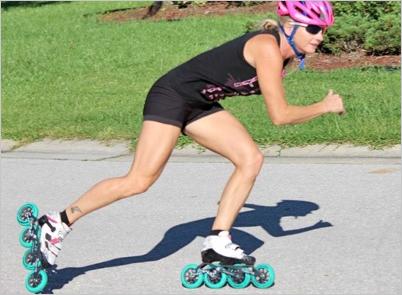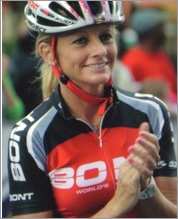This week's tip:
Power Points for Solo Training
Seven ways to amp up your solo skate training
By Debbie Rice

Debbie Rice during a solo training session
Photo courtesy: Debbie Rice
Many of the great skaters, including Chad Hedrick and Joey Mantia, will tell you this: they did most of their training alone, not in a group or with a team.
Training alone is simply a fact of life for inline skaters. And it’s not such a bad thing.
While skating with a group or team has its benefits, training solo allows you to focus on your goals and develop mental toughness.
I recently asked Joey to estimate what percent of his inline training was solo.
“I don't know exactly,” he said. “But for sure the majority was alone, although not by choice.”
Joey, who won 28 world titles before moving to the ice last year, told me he likes to think of group training as doing your homework and solo training as taking a test.
When you train in a group, “you have a lot of liberty to try new things and look for those ideal efficient pushes,” he said. And if your experiments fail, “it’s OK, because the pack will help you along.”
But once you develop some confidence, “you test yourself by skating alone,” he said. “The goal is to feel like skating alone is nearly as easy as it is with a pack. If you find yourself getting tired quickly, you’re doing something wrong, and it’s back to the homework.”
Wise words from a great skater.
As for me, I find myself doing more and more of my training on my own. I rarely have time to drive to group practices. So typically, I skate alone.
Not that I’m complaining. Over the years, I’ve learned to reap huge gains from my solo training. I've found the key is to use your mind, not just your muscles.
Here are some of the things that can help you get the most out of training solo:
1) Choose your ground.
Find a training course with plenty of variety: straightaways, turns (left and right), climbs, downhills, and good and bad pavement.
This will prepare you for whatever comes your way. And it makes things more interesting.
2) Push past your comfort zone.
Set your own pace, but don’t be a slacker. If you want to improve, you must push a pace that is uncomfortable.
3) Drill, baby, drill.
Work on your technique every time you go out. Get low as if sitting in a chair. Concentrate on your power transfers, pushing out to the side with your heels. Use your glutes (butt muscles) to drive your legs. Keep your core tight.
4) Change up your cadence.
Learn to vary your stride and cadence regularly. This helps keep exhaustion at bay. When you want to go faster, lower your body position, bend your knees and lengthen your strides. When you need to go a little easier, straighten up a bit and take smaller strides. Use a double-push stroke to trick your muscles into thinking they are getting a break.
5) Pretend your racing.
Use your imagination. Chase an imaginary breakaway. Once you catch it, imagine you are recovering from your effort and maintain your speed without getting dropped by the imaginary breakaway.
Later, rehearse your final sprint. Push yourself to an imaginary finish line, playing in your head what victory will feel like.
6) Get comfortable with hills.
Don’t simply roll down hills in a tuck. Adjust your stride — getting really low — and stroke down the hill. This will get you used to the intensity of a high speed paceline, speed wobbles and all.
When climbing, reach forward with your stroke and set your skates down in front of you. Don’t let them get too far behind you. If you do, you'll be wasting energy lifting them up the hill. And again, keep your core tight.
7) Yes, you can!
In solo training, there's no one pushing you. So it's easy to say, "I can't" and let off on the gas.
But fight the urge.
Imagine what you can do if you keep telling yourself, "I can!"
...
 Debbie Rice skated quads before inlines and became a master of both. She has won numerous titles, indoor and out, including the 2009 Master World Marathon Championship. She also holds the Guinness record for fastest woman on skates — 61 mph. A former cast member of the Roller Jam television series, she now jams for the Bont's Quadstar Derby Team. She is a Bont sales representative and team manager of Bont USA and Bont Quadstars Derby Team. A Houston native, she currently lives in Tampa.
Debbie Rice skated quads before inlines and became a master of both. She has won numerous titles, indoor and out, including the 2009 Master World Marathon Championship. She also holds the Guinness record for fastest woman on skates — 61 mph. A former cast member of the Roller Jam television series, she now jams for the Bont's Quadstar Derby Team. She is a Bont sales representative and team manager of Bont USA and Bont Quadstars Derby Team. A Houston native, she currently lives in Tampa.